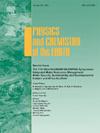Assessing meteorological droughts in the Çoruh River basin, Turkey: A probabilistic approach using SPI, SPEI, and copulas
IF 3
3区 地球科学
Q2 GEOSCIENCES, MULTIDISCIPLINARY
引用次数: 0
Abstract
This study presents a comprehensive analysis of meteorological drought characteristics in the Çoruh River Basin (ÇRB), utilizing both the Standardized Precipitation Index (SPI) and the Standardized Precipitation Evapotranspiration Index (SPEI). While previous research has examined droughts in the region, this study marks the first application of SPEI, offering a more holistic evaluation by integrating temperature-driven evapotranspiration effects. Drought events were identified using run theory, and their characteristics were systematically analyzed through univariate and bivariate frequency analyses. The Lognormal distribution was identified as the most suitable marginal distribution for both drought duration and severity, based on goodness-of-fit tests. Dependence structures between drought characteristics were modeled using copula functions, with the Gaussian copula providing the best fit for SPI and the Frank copula for SPEI. Return period analysis revealed a strong interdependence between drought duration and severity, with SPEI demonstrating superior capability in capturing prolonged drought events compared to SPI, particularly under rising temperature conditions. The findings underscore the limitations of precipitation-only indices in drought assessment and highlight the critical importance of incorporating temperature-sensitive indices like SPEI for accurate drought characterization. By employing advanced statistical methods, including copula-based modeling and joint return period analysis, this study establishes a robust framework for evaluating meteorological droughts and their probabilistic characteristics. The results emphasize the necessity of using temperature-inclusive drought indices for reliable risk assessments and climate adaptation planning. This research provides valuable insights for policymakers, hydrologists, and water resource managers, offering a foundation for enhanced drought monitoring, early warning systems, and mitigation strategies in the ÇRB and other drought-prone regions.
评估土耳其Çoruh河流域的气象干旱:使用SPI、SPEI和copulas的概率方法
利用标准化降水指数(SPI)和标准化降水蒸散指数(SPEI)对Çoruh河流域(ÇRB)的气象干旱特征进行了综合分析。虽然以前的研究已经考察了该地区的干旱,但这项研究标志着SPEI的首次应用,通过整合温度驱动的蒸散发效应,提供了更全面的评估。利用运行理论对干旱事件进行识别,并通过单变量和双变量频率分析系统地分析了干旱事件的特征。根据拟合优度检验,对数正态分布被确定为干旱持续时间和严重程度的最合适的边际分布。利用copula函数对干旱特征之间的依赖结构进行建模,其中高斯copula最适合SPI, Frank copula最适合SPEI。回归期分析显示,干旱持续时间和严重程度之间存在很强的相互依赖性,与SPI相比,SPEI在捕获长期干旱事件方面表现出更强的能力,特别是在温度升高的条件下。研究结果强调了仅降水指数在干旱评估中的局限性,并强调了将SPEI等温度敏感指数纳入准确干旱特征的重要性。本研究采用基于copula模型和联合回归期分析等先进的统计方法,建立了一个稳健的气象干旱及其概率特征评估框架。研究结果强调了使用含温度干旱指数进行可靠的风险评估和气候适应规划的必要性。这项研究为政策制定者、水文学家和水资源管理者提供了有价值的见解,为ÇRB和其他干旱易发地区加强干旱监测、预警系统和缓解战略奠定了基础。
本文章由计算机程序翻译,如有差异,请以英文原文为准。
求助全文
约1分钟内获得全文
求助全文
来源期刊

Physics and Chemistry of the Earth
地学-地球科学综合
CiteScore
5.40
自引率
2.70%
发文量
176
审稿时长
31.6 weeks
期刊介绍:
Physics and Chemistry of the Earth is an international interdisciplinary journal for the rapid publication of collections of refereed communications in separate thematic issues, either stemming from scientific meetings, or, especially compiled for the occasion. There is no restriction on the length of articles published in the journal. Physics and Chemistry of the Earth incorporates the separate Parts A, B and C which existed until the end of 2001.
Please note: the Editors are unable to consider submissions that are not invited or linked to a thematic issue. Please do not submit unsolicited papers.
The journal covers the following subject areas:
-Solid Earth and Geodesy:
(geology, geochemistry, tectonophysics, seismology, volcanology, palaeomagnetism and rock magnetism, electromagnetism and potential fields, marine and environmental geosciences as well as geodesy).
-Hydrology, Oceans and Atmosphere:
(hydrology and water resources research, engineering and management, oceanography and oceanic chemistry, shelf, sea, lake and river sciences, meteorology and atmospheric sciences incl. chemistry as well as climatology and glaciology).
-Solar-Terrestrial and Planetary Science:
(solar, heliospheric and solar-planetary sciences, geology, geophysics and atmospheric sciences of planets, satellites and small bodies as well as cosmochemistry and exobiology).
 求助内容:
求助内容: 应助结果提醒方式:
应助结果提醒方式:


